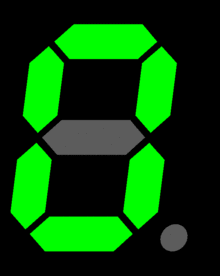Dihedral prime number
In entertainment mathematics , a dihedral prime number (from dihedral prime , also dihedral calculator prime ) is a prime number with the following property: if you look at it on a 7-segment display like a pocket calculator, the following four numbers must be:
- rotated by 180 °
- mirrored horizontally
- mirrored horizontally and then rotated by 180 °
all be prime numbers.
As with strobogrammatic numbers , dihedral prime numbers depend on their base . Usually the base is considered, i.e. the decimal system .
Mirroring and rotating the digits
The digits 0 to 9 and the other digits A to F common in the hexadecimal system can be shown on 7-segment displays (in the form AbCdEF, the two digits b and d, however, only in lower case).
The only digits that can be used for a dihedral prime are the digits 0, 1, 2, 5 and 8 in the decimal system. In the hexadecimal system , the digits 3 and E are added.
This is followed by a list of the properties of the digits 0 to 9 and the other digits A to F customary in the hexadecimal system.
- The numbers 0, 1 and 8 remain the same after rotation and mirroring. The 1 is shifted from the right to the left edge of the 7-segment display after a rotation or mirroring, but ultimately it still remains a 1.
- The digits 2 and 5 remain the same after the rotation, when mirroring the 2 changes into the 5 and vice versa the 5 changes into the 2.
- The number 3 becomes E both after mirroring and after rotation. Conversely, E becomes 3 both after mirroring and after rotation and is suitable for dihedral prime numbers in the hexadecimal system.
- After the rotation, the number 6 becomes a 9 and, conversely, the 9 becomes a 6 after the rotation. However, these two numbers do not result in valid numbers after the mirroring, so these two numbers are unsuitable for dihedral prime numbers.
- The digit A used in the hexadecimal system remains the same after mirroring, but rotated it does not result in a valid digit, which makes it unsuitable for dihedral prime numbers.
- The hexadecimal digit b becomes a d after mirroring and vice versa, d becomes a b after mirroring. However, even these two digits do not result in valid digits after the rotation and are therefore unsuitable.
- The numbers 4, 7, C and F do not result in valid numbers either when rotated or when mirrored and are therefore unsuitable.
Examples
- The smallest dihedral prime numbers are the following:
- The smallest dihedral prime number, which results in a different prime number with every rotation or reflection, is the number which, rotated by 180 °, results in the prime number , mirrored the prime number and mirrored and rotated by 180 °, the prime number .
- The smallest dihedral prime number with all valid digits is . There are 2958 more such numbers up . The largest dihedral prime number is up with all valid digits .
- The largest known dihedral prime is the following (as of February 5, 2020):
- It was discovered by Darren Bedwell in 2009 and has 180,055 jobs.
useful information
- Strobogrammatic primes in which no 6 and no 9 appear are dihedral prime numbers.
- Prime numbers that are repunits are dihedral prime numbers.
- Prime number palindromes in which only the digits 0, 1 and 8 occur are dihedral prime numbers.
Dihedral prime numbers in other number systems
- In the dual system , i.e. in the number system with a basis , all prime number palindromes are dihedral prime numbers.
- (This follows from the above sentence that prime number palindromes, in which only the digits 0, 1 and 8 occur, are dihedral prime numbers. Since there are only zeros and ones in the binary system, this condition is fulfilled.)
- In the hexadecimal system , i.e. in the number system with a base , there are no dihedral prime numbers that start with 3.
-
Proof:
- Suppose there is a dihedral prime number in the hexadecimal system that starts with 3. Then the horizontally mirrored number ends with E. But since in the hexadecimal system, in addition to 0, 2, 4, 6 and 8, A, C and E are even numbers, the horizontally mirrored number that ends with E would be an even number and therefore not Be prime. Thus there can not be a dihedral prime. The assumption must be dropped that there is no dihedral prime number in the hexadecimal system that starts with 3.
-
Proof:
See also
Web links
- Eric W. Weisstein : Dihedral Prime . In: MathWorld (English).
- Chris K. Caldwell: dihedral prime. Prime Pages, accessed February 7, 2020 .
- dihedral prime. PlanetMath , accessed February 7, 2020 .
- Check whether N is a Dihedral Prime Number or not. Programs for the calculation of dihedral prime numbers. GeeksforGeeks - A computer science portal for geeks, accessed February 7, 2020 .
- Chris K. Caldwell: The Top Twenty: Palindromes. Prime Pages, accessed February 5, 2020 .
Individual evidence
- ↑ Mike Keith: Puzzle 39 - The Mirrorable Numbers. The prime puzzles & problems connection, accessed February 5, 2020 .
- ↑ Example for OEIS
- ↑ Comment on OEIS
- ↑ Patrick De Geest: Palindromic Primes, September 2 , 2007. World! Of Numbers, accessed February 8, 2020 .
















